LAND ROVER DEFENDER 1999 Workshop Manual
Manufacturer: LAND ROVER, Model Year: 1999, Model line: DEFENDER, Model: LAND ROVER DEFENDER 1999Pages: 667, PDF Size: 8.76 MB
Page 561 of 667
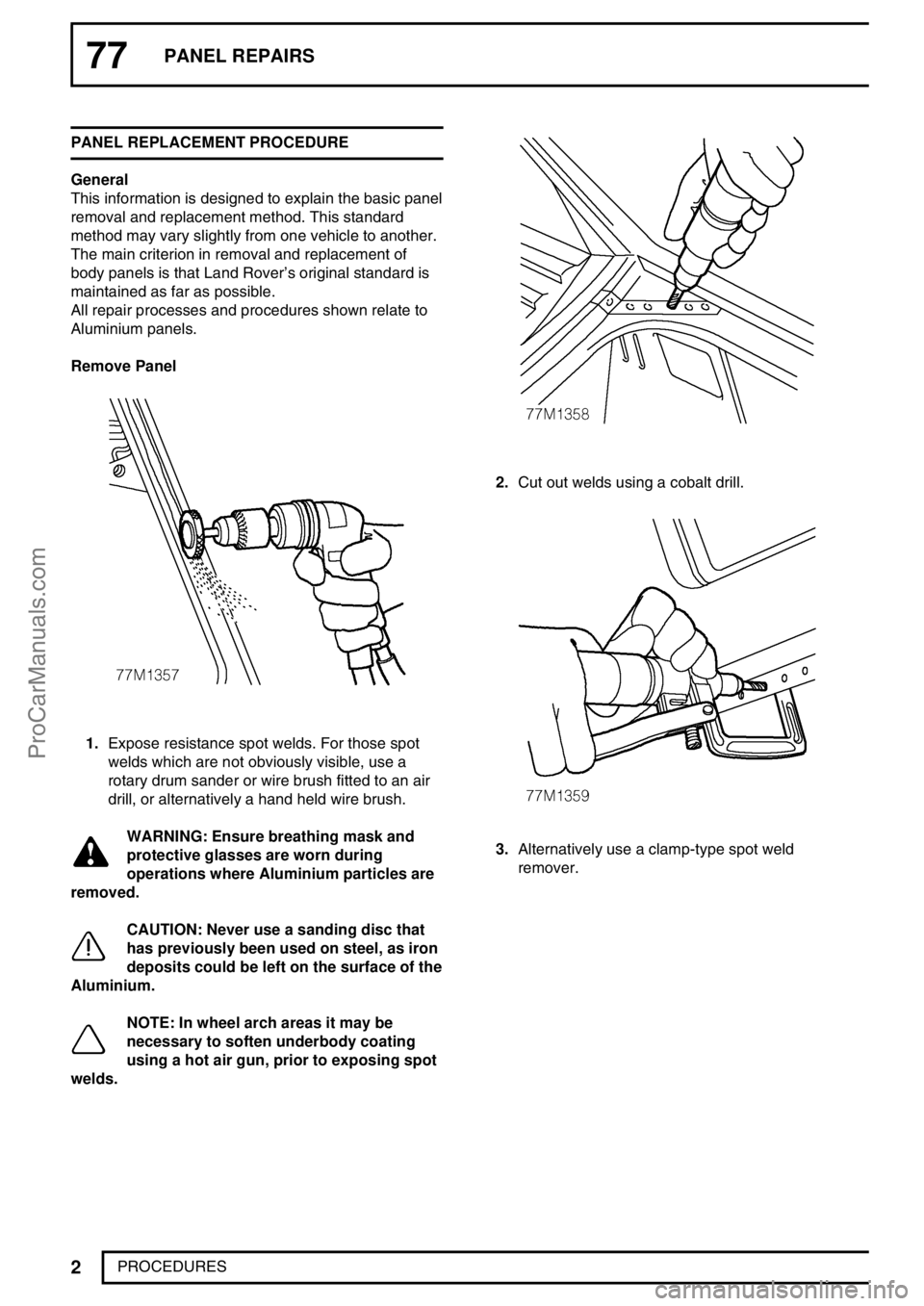
77PANEL REPAIRS
2
PROCEDURES PANEL REPLACEMENT PROCEDURE
General
This information is designed to explain the basic panel
removal and replacement method. This standard
method may vary slightly from one vehicle to another.
The main criterion in removal and replacement of
body panels is that Land Rover’s original standard is
maintained as far as possible.
All repair processes and procedures shown relate to
Aluminium panels.
Remove Panel
1.Expose resistance spot welds. For those spot
welds which are not obviously visible, use a
rotary drum sander or wire brush fitted to an air
drill, or alternatively a hand held wire brush.
WARNING: Ensure breathing mask and
protective glasses are worn during
operations where Aluminium particles are
removed.
CAUTION: Never use a sanding disc that
has previously been used on steel, as iron
deposits could be left on the surface of the
Aluminium.
NOTE: In wheel arch areas it may be
necessary to soften underbody coating
using a hot air gun, prior to exposing spot
welds.
2.Cut out welds using a cobalt drill.
3.Alternatively use a clamp-type spot weld
remover.
ProCarManuals.com
Page 562 of 667
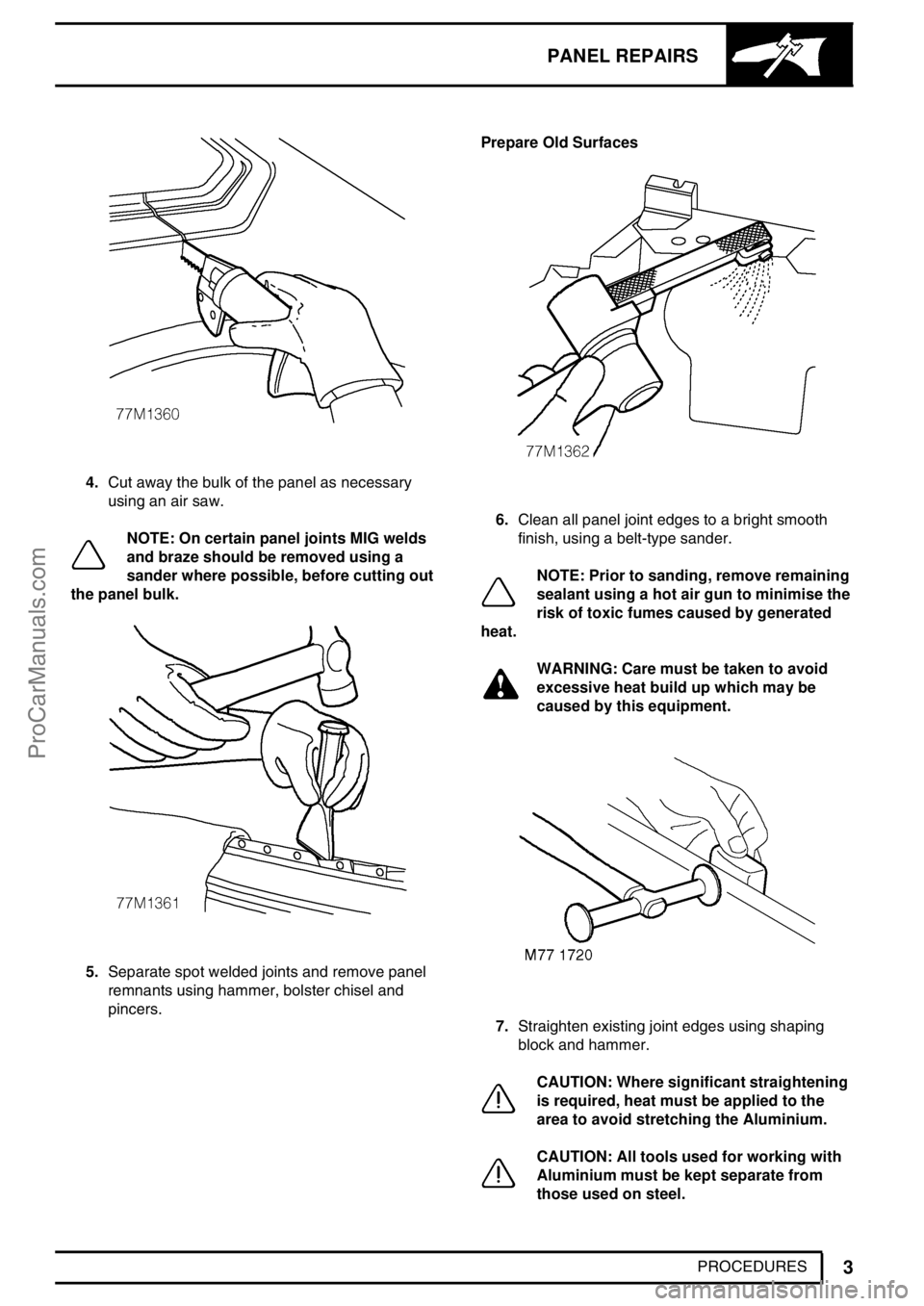
PANEL REPAIRS
3
PROCEDURES
4.Cut away the bulk of the panel as necessary
using an air saw.
NOTE: On certain panel joints MIG welds
and braze should be removed using a
sander where possible, before cutting out
the panel bulk.
5.Separate spot welded joints and remove panel
remnants using hammer, bolster chisel and
pincers.Prepare Old Surfaces
6.Clean all panel joint edges to a bright smooth
finish, using a belt-type sander.
NOTE: Prior to sanding, remove remaining
sealant using a hot air gun to minimise the
risk of toxic fumes caused by generated
heat.
WARNING: Care must be taken to avoid
excessive heat build up which may be
caused by this equipment.
7.Straighten existing joint edges using shaping
block and hammer.
CAUTION: Where significant straightening
is required, heat must be applied to the
area to avoid stretching the Aluminium.
CAUTION: All tools used for working with
Aluminium must be kept separate from
those used on steel.
ProCarManuals.com
Page 563 of 667
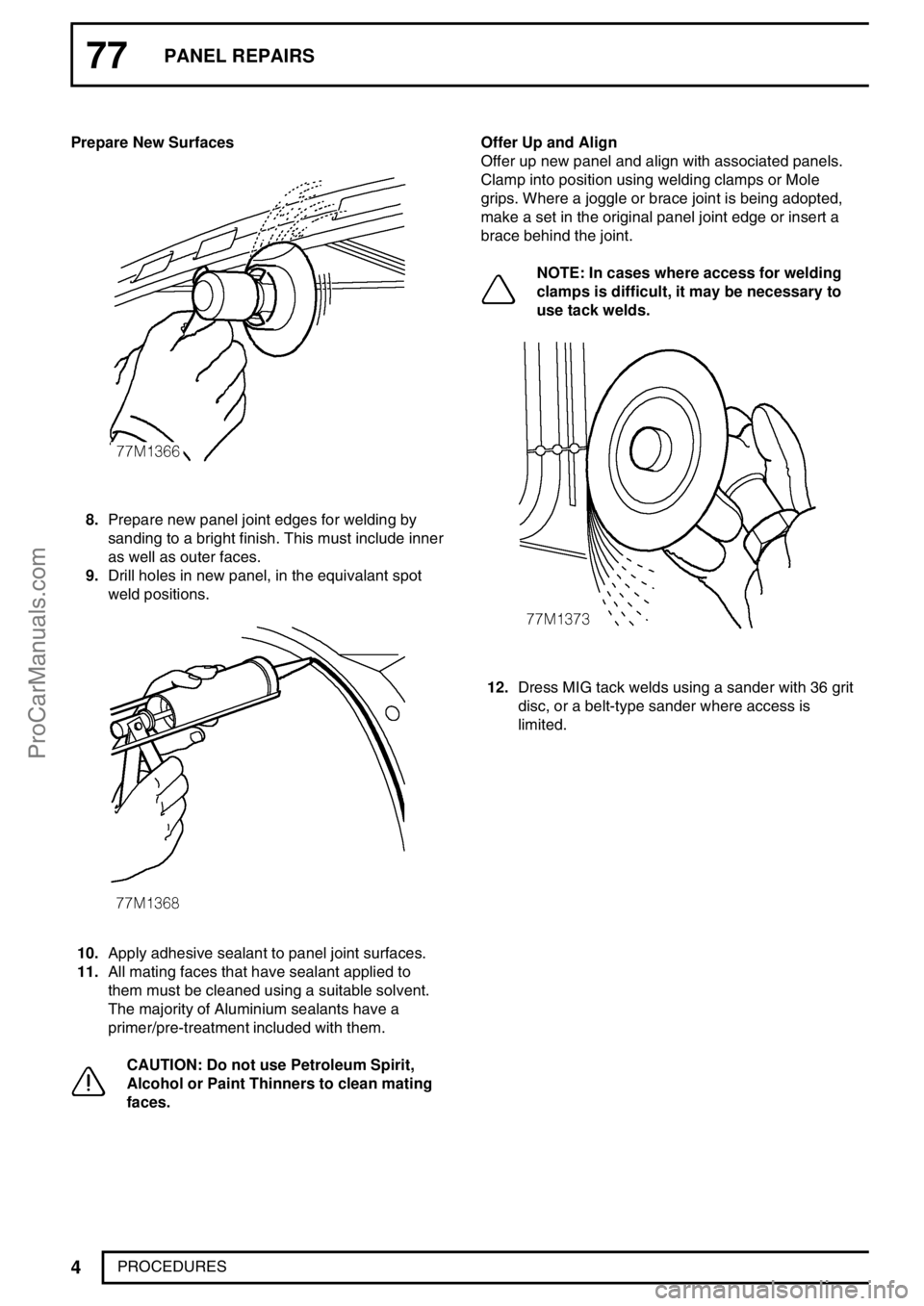
77PANEL REPAIRS
4
PROCEDURES Prepare New Surfaces
8.Prepare new panel joint edges for welding by
sanding to a bright finish. This must include inner
as well as outer faces.
9.Drill holes in new panel, in the equivalant spot
weld positions.
10.Apply adhesive sealant to panel joint surfaces.
11.All mating faces that have sealant applied to
them must be cleaned using a suitable solvent.
The majority of Aluminium sealants have a
primer/pre-treatment included with them.
CAUTION: Do not use Petroleum Spirit,
Alcohol or Paint Thinners to clean mating
faces.Offer Up and Align
Offer up new panel and align with associated panels.
Clamp into position using welding clamps or Mole
grips. Where a joggle or brace joint is being adopted,
make a set in the original panel joint edge or insert a
brace behind the joint.
NOTE: In cases where access for welding
clamps is difficult, it may be necessary to
use tack welds.
12.Dress MIG tack welds using a sander with 36 grit
disc, or a belt-type sander where access is
limited.
ProCarManuals.com
Page 564 of 667
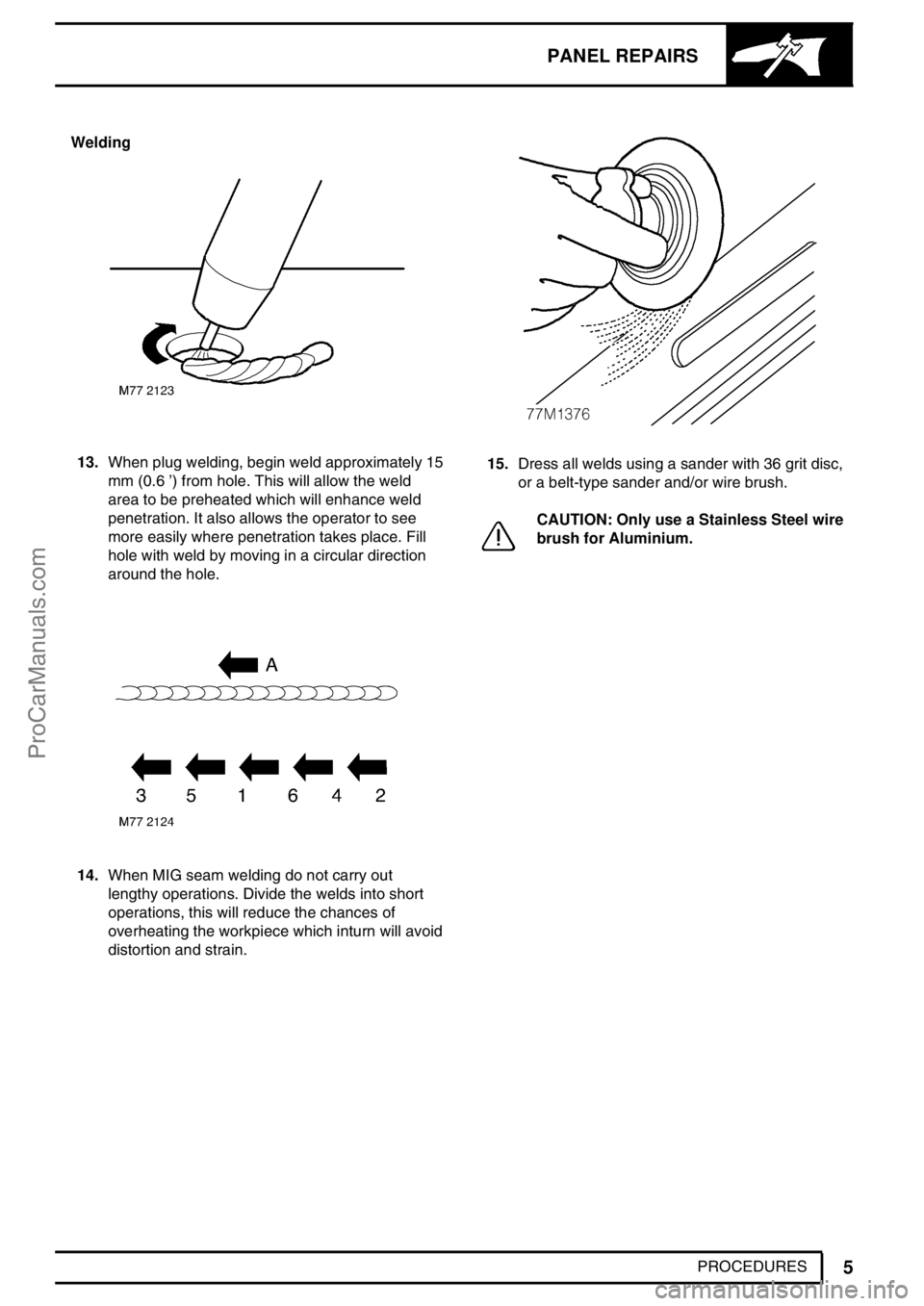
PANEL REPAIRS
5
PROCEDURES Welding
13.When plug welding, begin weld approximately 15
mm (0.6’) from hole. This will allow the weld
area to be preheated which will enhance weld
penetration. It also allows the operator to see
more easily where penetration takes place. Fill
hole with weld by moving in a circular direction
around the hole.
14.When MIG seam welding do not carry out
lengthy operations. Divide the welds into short
operations, this will reduce the chances of
overheating the workpiece which inturn will avoid
distortion and strain.
15.Dress all welds using a sander with 36 grit disc,
or a belt-type sander and/or wire brush.
CAUTION: Only use a Stainless Steel wire
brush for Aluminium.
ProCarManuals.com
Page 565 of 667
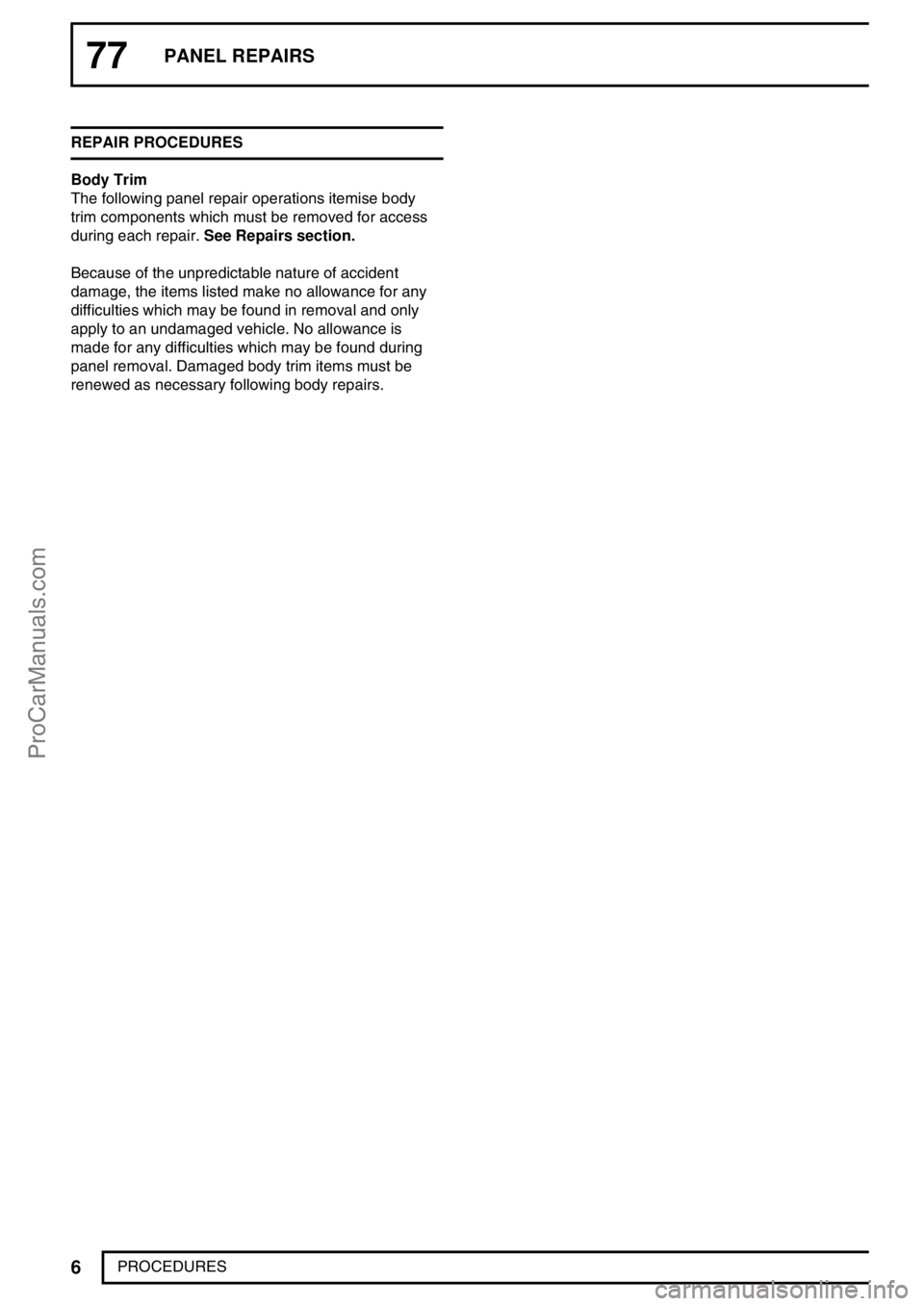
77PANEL REPAIRS
6
PROCEDURES REPAIR PROCEDURES
Body Trim
The following panel repair operations itemise body
trim components which must be removed for access
during each repair.See Repairs section.
Because of the unpredictable nature of accident
damage, the items listed make no allowance for any
difficulties which may be found in removal and only
apply to an undamaged vehicle. No allowance is
made for any difficulties which may be found during
panel removal. Damaged body trim items must be
renewed as necessary following body repairs.
ProCarManuals.com
Page 566 of 667
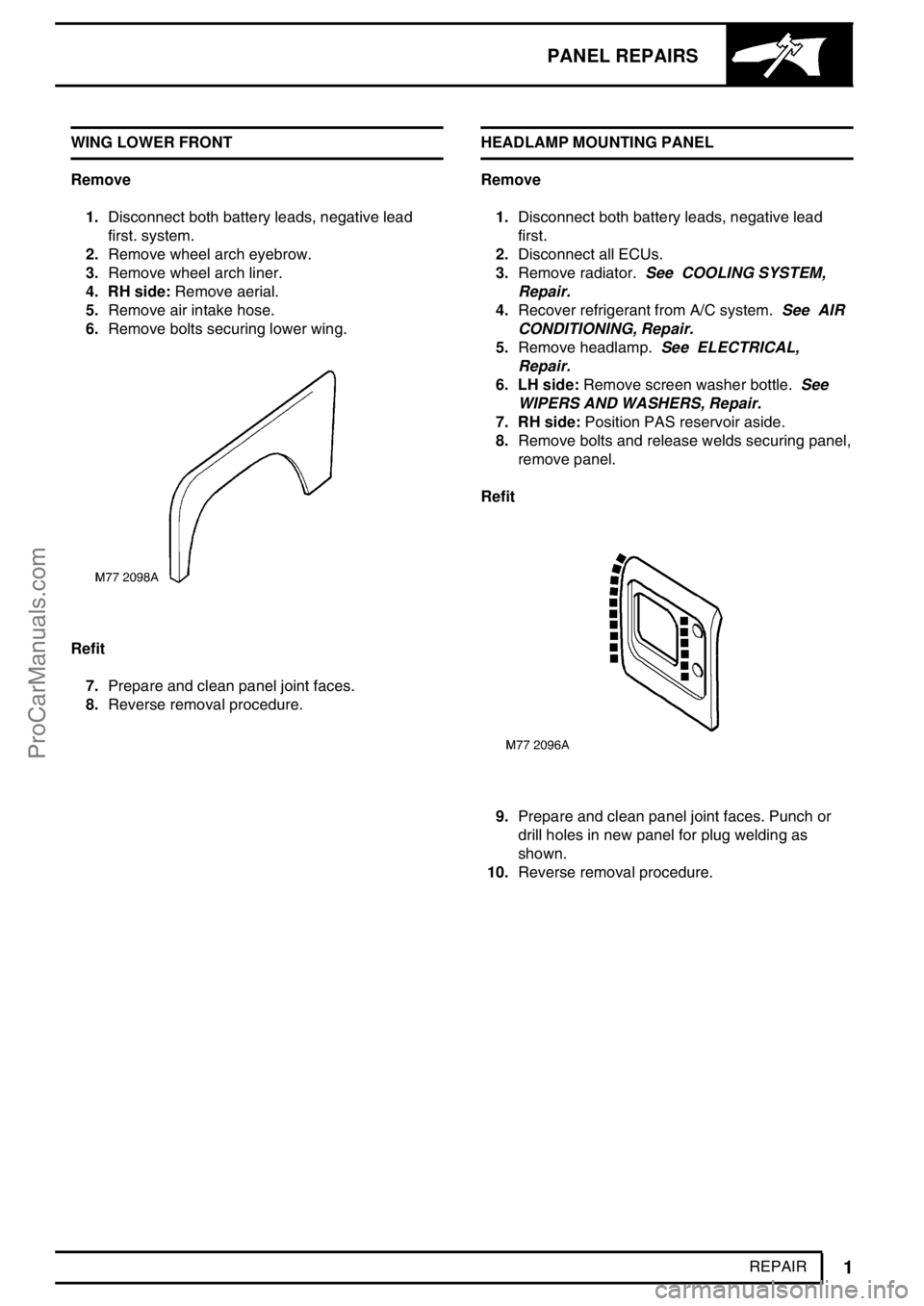
PANEL REPAIRS
1
REPAIR WING LOWER FRONT
Remove
1.Disconnect both battery leads, negative lead
first. system.
2.Remove wheel arch eyebrow.
3.Remove wheel arch liner.
4. RH side:Remove aerial.
5.Remove air intake hose.
6.Remove bolts securing lower wing.
Refit
7.Prepare and clean panel joint faces.
8.Reverse removal procedure.HEADLAMP MOUNTING PANEL
Remove
1.Disconnect both battery leads, negative lead
first.
2.Disconnect all ECUs.
3.Remove radiator.See COOLING SYSTEM,
Repair.
4.Recover refrigerant from A/C system.See AIR
CONDITIONING, Repair.
5.Remove headlamp.See ELECTRICAL,
Repair.
6. LH side:Remove screen washer bottle.See
WIPERS AND WASHERS, Repair.
7. RH side:Position PAS reservoir aside.
8.Remove bolts and release welds securing panel,
remove panel.
Refit
9.Prepare and clean panel joint faces. Punch or
drill holes in new panel for plug welding as
shown.
10.Reverse removal procedure.
ProCarManuals.com
Page 567 of 667

77PANEL REPAIRS
2
REPAIR WING UPPER - LH
Remove
1.Disconnect both battery leads, negative lead
first.
2.Remove headlamp.See ELECTRICAL,
Repair.
3.Remove headlamp mounting panel.See this
Section.
4.Remove radiator.See COOLING SYSTEM,
Repair.
5.Recover refrigerant from A/C system.See AIR
CONDITIONING, Repair.
6.Remove receiver drier.See AIR
CONDITIONING, Repair.
7.Remove relevant A/C pipes.
8.Remove relevant heater intake pipes.
9.Remove screen washer bottle.
10.Remove wheel arch liner.See CHASSIS AND
BODY, Repair.
11.Remove bolts and release welds securing panel,
remove panel.
Refit
12.Prepare and clean panel joint faces.
13.Reverse removal procedure.
14.Align headlamps.See ELECTRICAL,
Adjustment.WING UPPER - RH
Remove
1.Disconnect both battery leads, negative lead
first.
2.Remove headlamp.See ELECTRICAL,
Repair.
3.Remove headlamp mounting panel.See this
Section.
4.Remove radiator.See COOLING SYSTEM,
Repair.
5.Recover refrigerant from A/C system.See AIR
CONDITIONING, Repair.
6.Remove relevant A/C pipes.
7.Position PAS reservoir aside.
8.Remove wheel arch liner.See CHASSIS AND
BODY, Repair.
9.Remove aerial.
10.Remove vacuum solenoid valve.
11.Release clips securing coolant reservoir.
12.Remove bolts and release welds securing panel,
remove panel.
Refit13.Prepare and clean panel joint faces.
NOTE: LH panel shown
14.Reverse removal procedure.
15.Align headlamps.See ELECTRICAL,
Adjustment.
ProCarManuals.com
Page 568 of 667

PANEL REPAIRS
3
REPAIR WHEEL ARCH - FRONT
Remove
The procedure to change the Inner Front Wheelarch is
the same as for the Wing Upper, except for removal of
the ABS sensors and shield, if fitted.
BULKHEAD ASSEMBLY
Remove
1.Disconnect both battery leads, negative lead
first.
2.Remove front lower wing.See this Section.
3.Remove RH and LH front upper wing.See this
Section.
4.Remove headlamp mounting panels.See this
Section.
5.Remove screen aperture.See this Section.
6.Remove both front doors.
7.Remove lower fascia panel.See CHASSIS
AND BODY, Repair.
8. Models with A/C:Remove relevant A/C pipes.
9.Remove front grille.
10.Drain cooling system.See COOLING
SYSTEM, Adjustment.
11.Remove radiator and intercooler.
12. Models with A/C:Remove condensor.
13.Remove air cleaner assembly.
14.Remove heater unit.See HEATING AND
VENTILATION, Repair.
15.Remove brake servo assembly.
16.Remove heater ducts.
17.Remove both front seats.
18.Remove front carpets.
19.Release all relevant harnesses and position
aside.
20.Remove facia support bracket.
Refit
21.Prepare and clean panel joint faces. Ensure all
necessary grommets and sealant is applied to
new bulkhead.
22.Reverse removal procedure.
23.Bleed brake system.See BRAKES,
Adjustment.
24.Align headlamps.See ELECTRICAL,
Adjustment.
25.Water test after refitting.
ProCarManuals.com
Page 569 of 667
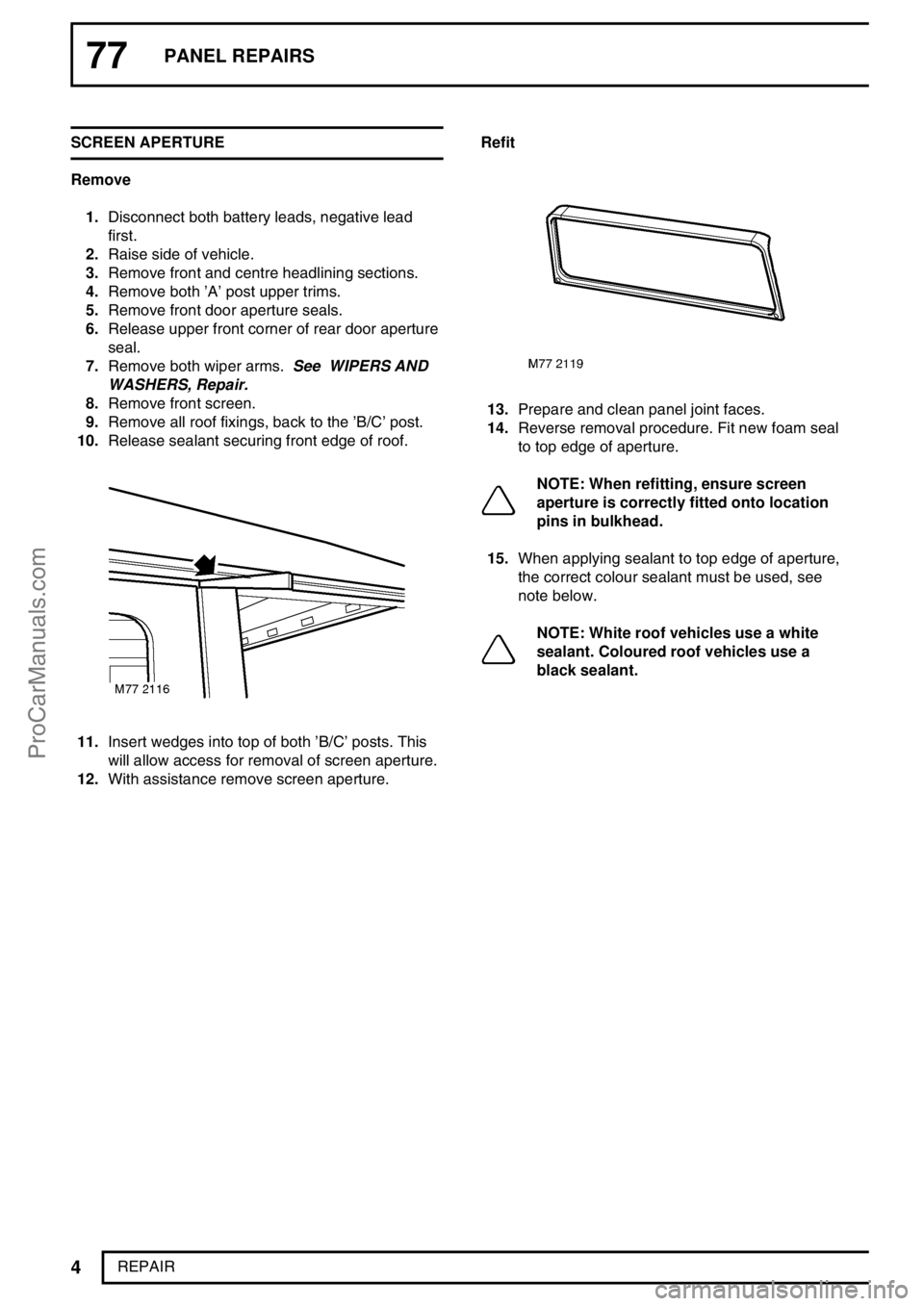
77PANEL REPAIRS
4
REPAIR SCREEN APERTURE
Remove
1.Disconnect both battery leads, negative lead
first.
2.Raise side of vehicle.
3.Remove front and centre headlining sections.
4.Remove both’A’post upper trims.
5.Remove front door aperture seals.
6.Release upper front corner of rear door aperture
seal.
7.Remove both wiper arms.See WIPERS AND
WASHERS, Repair.
8.Remove front screen.
9.Remove all roof fixings, back to the’B/C’post.
10.Release sealant securing front edge of roof.
11.Insert wedges into top of both’B/C’posts. This
will allow access for removal of screen aperture.
12.With assistance remove screen aperture.Refit
13.Prepare and clean panel joint faces.
14.Reverse removal procedure. Fit new foam seal
to top edge of aperture.
NOTE: When refitting, ensure screen
aperture is correctly fitted onto location
pins in bulkhead.
15.When applying sealant to top edge of aperture,
the correct colour sealant must be used, see
note below.
NOTE: White roof vehicles use a white
sealant. Coloured roof vehicles use a
black sealant.
ProCarManuals.com
Page 570 of 667
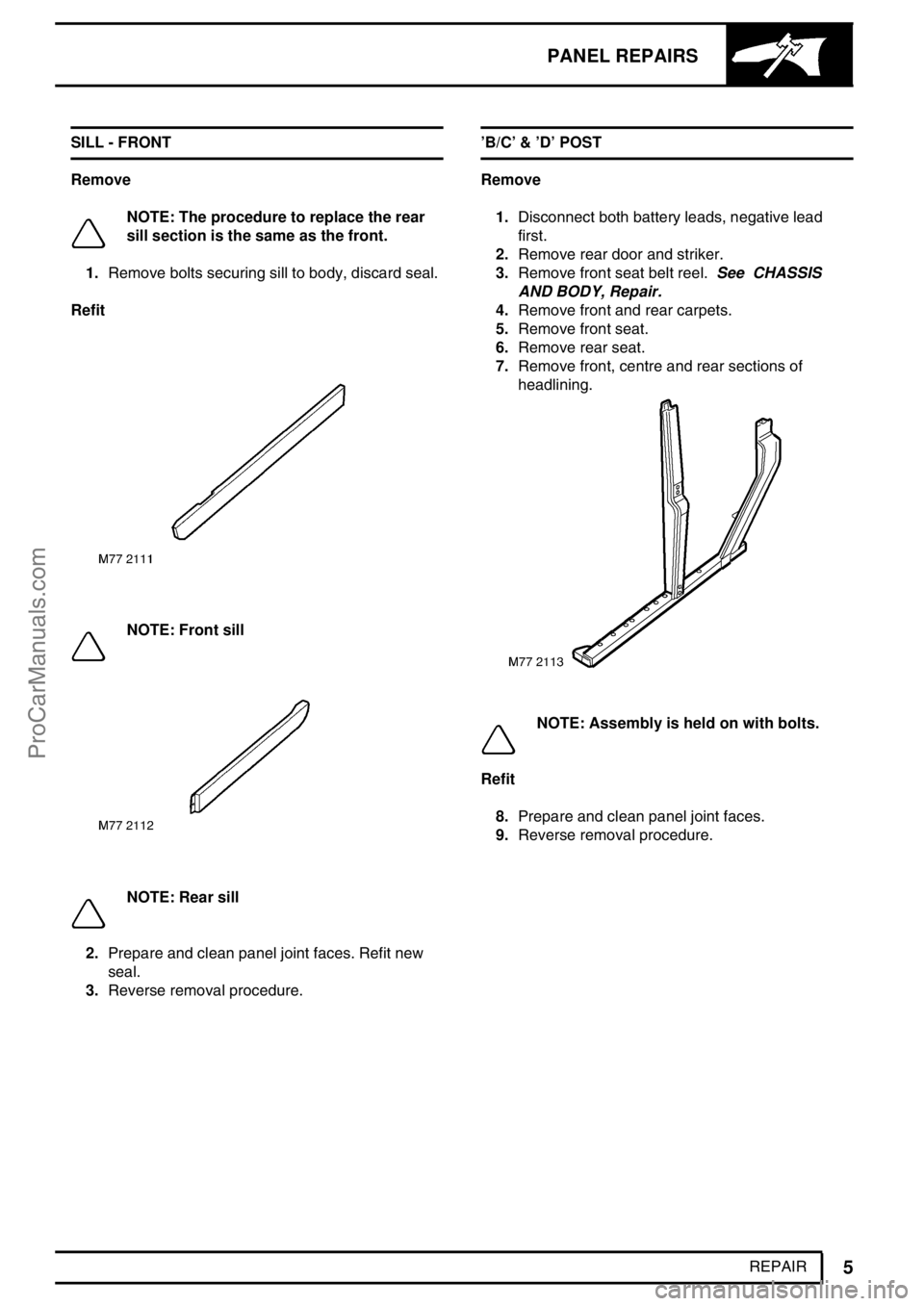
PANEL REPAIRS
5
REPAIR SILL - FRONT
Remove
NOTE: The procedure to replace the rear
sill section is the same as the front.
1.Remove bolts securing sill to body, discard seal.
Refit
NOTE: Front sill
NOTE: Rear sill
2.Prepare and clean panel joint faces. Refit new
seal.
3.Reverse removal procedure.’B/C’&’D’POST
Remove
1.Disconnect both battery leads, negative lead
first.
2.Remove rear door and striker.
3.Remove front seat belt reel.See CHASSIS
AND BODY, Repair.
4.Remove front and rear carpets.
5.Remove front seat.
6.Remove rear seat.
7.Remove front, centre and rear sections of
headlining.
NOTE: Assembly is held on with bolts.
Refit
8.Prepare and clean panel joint faces.
9.Reverse removal procedure.
ProCarManuals.com